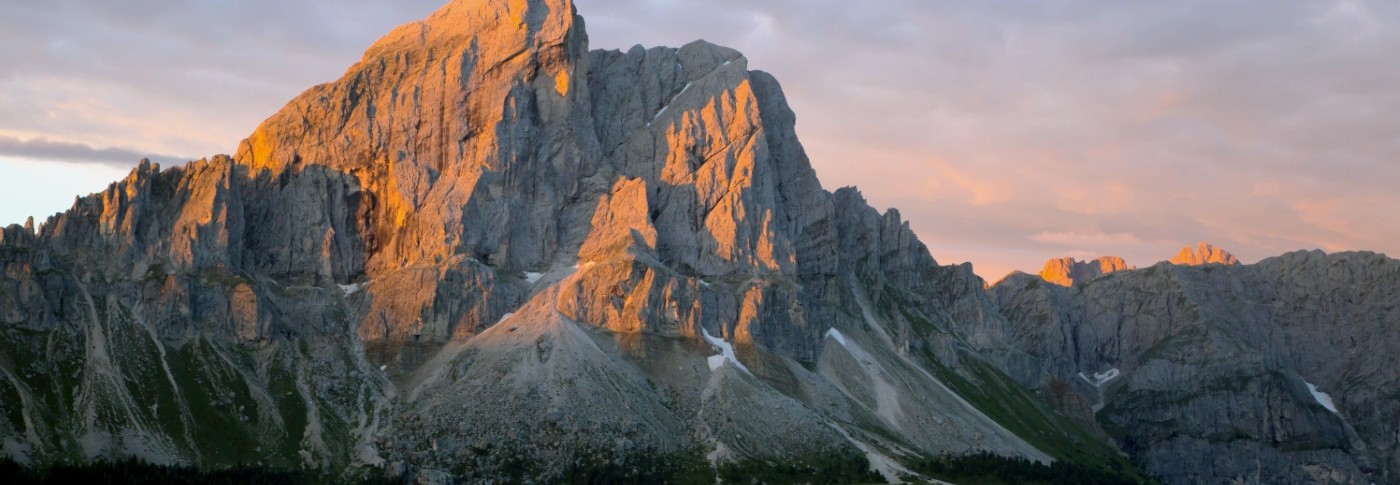Alpine mountaineering over the years
Back in 1884 the Pütia/Peitlerkofel (2.876 m) was described by Johann Santner as a “top-class vantage point.” Due to its outlying location the summit, which can be seen from far and wide, is considered to be the most north-westerly cornerstone of the Dolomites. Not many people know that it lies entirely within the territory of Lungiarü, and is the village’s local mountain. Most of its climbing routes are on the vertical north face, including the Messner Route, ranked as difficulty level VI, and named for its first ascenders, Reinhold and Günther Messner from the neighbouring Villnöss Valley, in 1986. The most-climbed route is the Hruschka, which is also on the north face and is ranked at difficulty level IV-V.
In his tour book, Hans Pescoller, born in Lungiarü, described the ascent of the north face of the Peitler over the Hruschka route together with Heini Holzer in 1968 as “The fulfilment of what had been his greatest mountaineering desire.” In 1963 Hans Pescoller, author of tour guides and photo books, was the first to ascend the north-east face of the Crëp dales Dodesc/Zwölferkofel (2.403 m), ranked at difficulty III, and, in 1971, the north face of the Capuziner (2.710 m) together with Hans Steger, at difficulty level V. The fact that the Pütia/Peitlerkofel remains of interest to mountaineers to this day is confirmed by the first ascent of the “Traverso al Cielo” on the south face in 2015 by Simon Kehrer and Christoph Hainz, at difficulty level 7b (obl. 6c) and the “Fornella Express” route on the Peitlerkofelturm at difficulty level VII, by Alex and Kurt Pfattner.
The AVS regional branch of San Martin de Tor/St. Martin in Thurn
The first section of the Gadertal Valley was founded in 1886 in what was at that time the German-Austrian Alpine Association, under Jan Batista Alton from Calfosch/Kolfuschg. The association was banned with the arrival of WW1, a situation which was to continue through to WW2, although mountaineering carried on without the support of an official organisation in the interim period. In 1954 the CAI Val Badia Alpine Association was founded, followed shortly afterwards by the AVS Mareo/Enneberg and AVS La Val/ Wengen, both satellite sites of the Bruneck section.
The Alpine Associations of the Gadertal Valley, AVS and CAI, have been a single organisation, the Lia da Munt Ladinia Val Badia, since 2012. On 20 May 2018, the San Martin de Tor/St. Martin in Thurn branch was inaugurated; the branch leader is Elmar Dapoz from Lungiarü and the regional branch currently counts 177 members, of which roughly one-third are natives to Lungiarü.
On 1 June 2016, a further milestone was reached: The local sections of the AVS in Mareo/Enneberg and La Val/Wengen joined forces with the newly-founded San Martin de Tor/St. Martin in Thurn and that of Fodom/Buchenstein, forming the new AVS Ladinia section. The 130-year long history of the AVS in the Gadertal Valley is one of continuous development and, from its humble beginnings, the niche interest-group has grown to become a large family. Including local offices, AVS Ladinia currently boasts 1,300 members, a figure which is constantly on the up.

